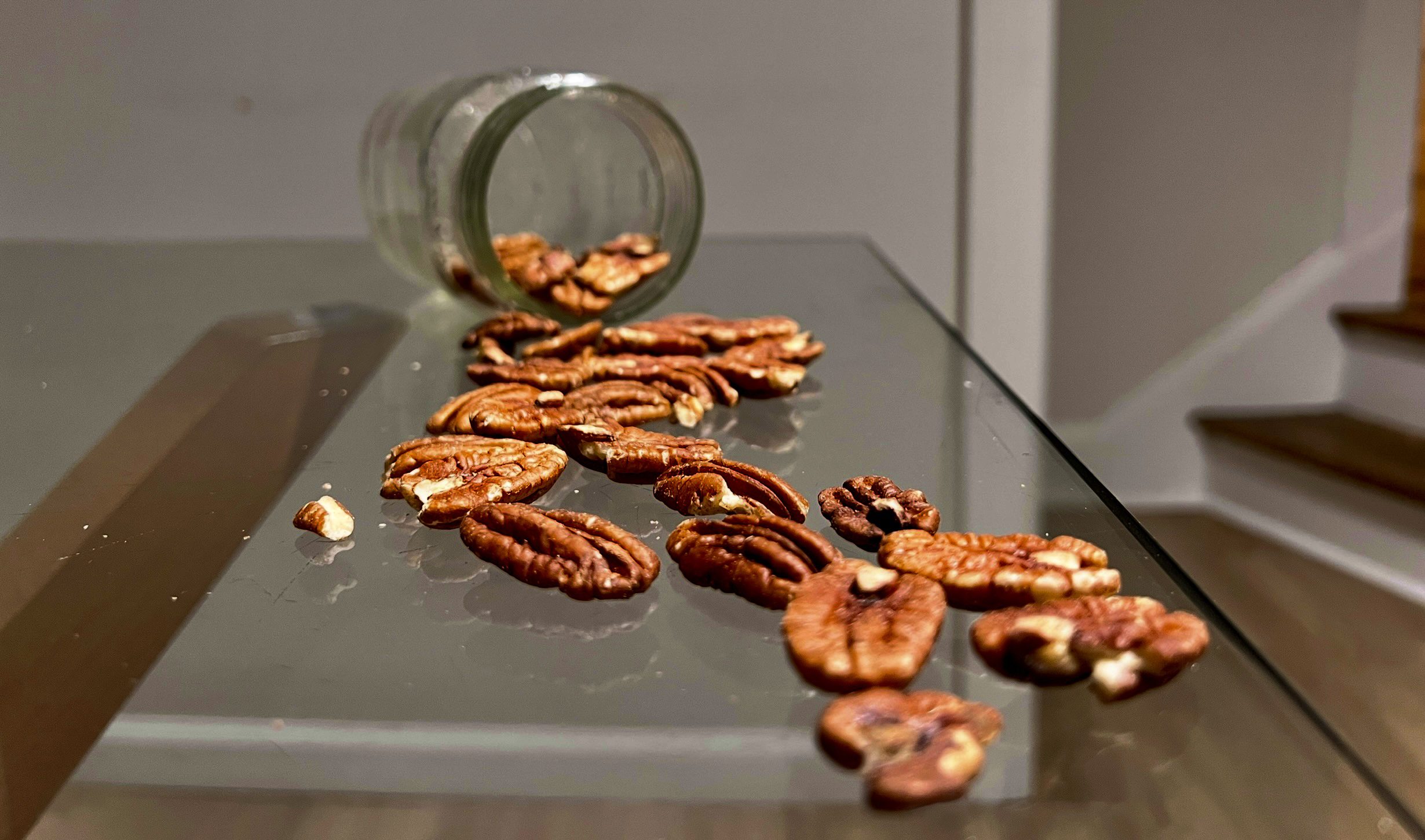
Last weekend I was reading the Sunday Times and snacking. I was looking at the paper and not my food, which was pecans from a glass jar. As I arrived at the bottom of the jar, I looked down and noticed little cobwebs all around the edges of the glass. Most of the remaining pecans had clearly been munched on already, and not by me. On closer inspection, I could see that between the ridges of most of the pecans there were little grain-moth pupae resting peaceably in their tight little cocoons. Nice, I thought—that probably makes a whole protein. I also gagged a bit.
The pecans had clearly been munched on already, and not by me.
But as I contemplated my situation, I set my stomach to rest with recollections of termites I had eaten as part of a meal in northeastern Thailand, and also a big brown spider I once found half of in my curry there. I remember complaining to the waiter at this not-so-inexpensive restaurant. He inspected my find. “It’s a spider!” he said with a happy laugh. “That’s not a bad bug, like a cockroach.” I can’t remember for certain, but he may have also said, “You should finish it.”
I didn’t.
How does this relate to branding?
If you were a kid in the ’70s you’ll remember the following dialogue. It was a great piece of TV advertising created in 1971 by Doyle, Dane & Bernbach. It got saturation airplay during Saturday mornings throughout the ’70s.
Two kids talking:
A: “What’s this stuff?”
B: “Some cereal. It’s supposed to be good for you.”
A: “I’m not gonna try it.”
B: “Let’s get Mikey! He won’t eat it. He hates everything.”
A: “Yeah!”
…
B: “He likes it! Hey Mikey!”
See the original:
I saw the ads. My mom bought the cereal. I liked it. The experience of eating Life cereal met the expectation raised by the commercials. It was good, and if you read the box, it did seem that it was good for you. I was a satisfied consumer and a brand convert. I had been won by savvy advertising and careful brand messaging.
I had been won by savvy advertising and careful brand messaging.
Then, one morning in the early ’80s, when I was a teenager and the campaign was still running, I was particularly hungry and poured myself a huge bowl of the stuff. As I ate, I read the box. It had lots of interesting stuff written on it. When I was nearly finished, I looked down into my bowl, now mostly milk. It was swarming with little brown bugs. They seemed to be swimming little somersaults in the milk, coming in and out of view at the surface.
Brands are personal. They do not live in and cannot ultimately be controlled by the corporate brand managers or corporate planning offices. No matter how well executed a brand strategy, the brand really lives in the mind of the brand consumer. This may be the employees of the company, or the purchasers of a product, or anyone else who interacts with the brand. In the case of me at age twelve, I had seen some compelling advertising and been converted. But on the day of the bugs, I threw out my bowl of milk and my box of cereal, and to this day I have not tasted another square of Life cereal.
No matter how well executed a brand strategy, the brand really lives in the mind of the brand consumer.
OK, understandable. But here’s the interesting part—I’ve already started eating pecans again, after only a few days. This is the difference between a truly honest pitch (pecans actually are tasty AND good for you) and what is essentially a marketing strategy. Life cereal has enough sugar in it to be tasty, and it has been fortified with vitamins and iron, but it is not good for you in any fundamental way, so there’s nothing that would require you to get past an experience with bugs in the box—let bygones be bygones, admit it wasn’t really the manufacturer’s fault anyway. The brand trust I had established with Life cereal was superficial, and could, therefore, be obliterated forever by a relatively minor incident. If the Life brand had been based on some essential truth, it should have withstood the test of the bugs, but in the end, the brand was based on marketing and a bit of exaggeration. And so it was, for me at sixteen, deposed as a trustworthy brand.
“I am a tasty and healthy food and snack” is not driven by marketing. It is 100% true.
The other brand in this story—the pecan (Is there a Pecan Ad Council? It turns out there is.)—is interesting because of its brand message: “I am a tasty and healthy food and snack” is not driven by marketing. It is 100% true. It has staying power even though (I assume) almost no money has ever been spent promoting its virtues. Neither are essential foodstuffs. Both have lots of viable alternatives for your loyalty and trust. But for me, pecans are very resistant to the damage caused by the bug test, even with no marketing budget, as compared to the untold millions that have supported the creation of consumer demand for Life cereal.
This is to my mind an extremely good illustration of what good branding does as opposed to what advertising typically does, and why branding based on the truth can be so much more effective with so much less money. Good branding involves understanding the truth of a product or service and finding the best ways to communicate this to those naturally receptive to hearing it. What Doyle, Dane & Bernbach did so brilliantly and effectively was something ad agencies generally do very well—exaggerate/extend/develop an effective and well-targeted marketing platform out of something that is … let’s say … not obviously false.
Good branding involves understanding the truth of a product or service and finding the best ways to communicate this to those naturally receptive to hearing it.
I think my Life cereal experience is analogous to what any brand consumer goes through when they have been given a pitch that is only half true. If a brand says that it is one thing and it delivers something else, particularly something inferior, the consumer can be lost to that brand forever. If, however, the brand makes an honest pitch and then fails in some way, as did my pecans, the brand can recover much more easily. Pecans remain a healthy and tasty snack. Temporary failings do little lasting harm to such a brand because the truth continues to shine through. This is, for me, one hallmark of a strong brand—it is built on a foundation that is its essence, and this is borne out in the consumer’s lived experience of that brand.
Have a pecan.
Do you need an affordable way to improve your brand today?
Because we know that not everyone needs or can afford our full process, we created a guided tutorial package for our foundational brand strategy tool: the Brand Pyramid. Watch the video for a preview.
For more information on the brand strategy tutorial, visit here where you will find a fuller explanation and link to a free download of the first video.
Photo by the author



Ask for help.
We are kind, thorough and ready when you are. You just need to ask.